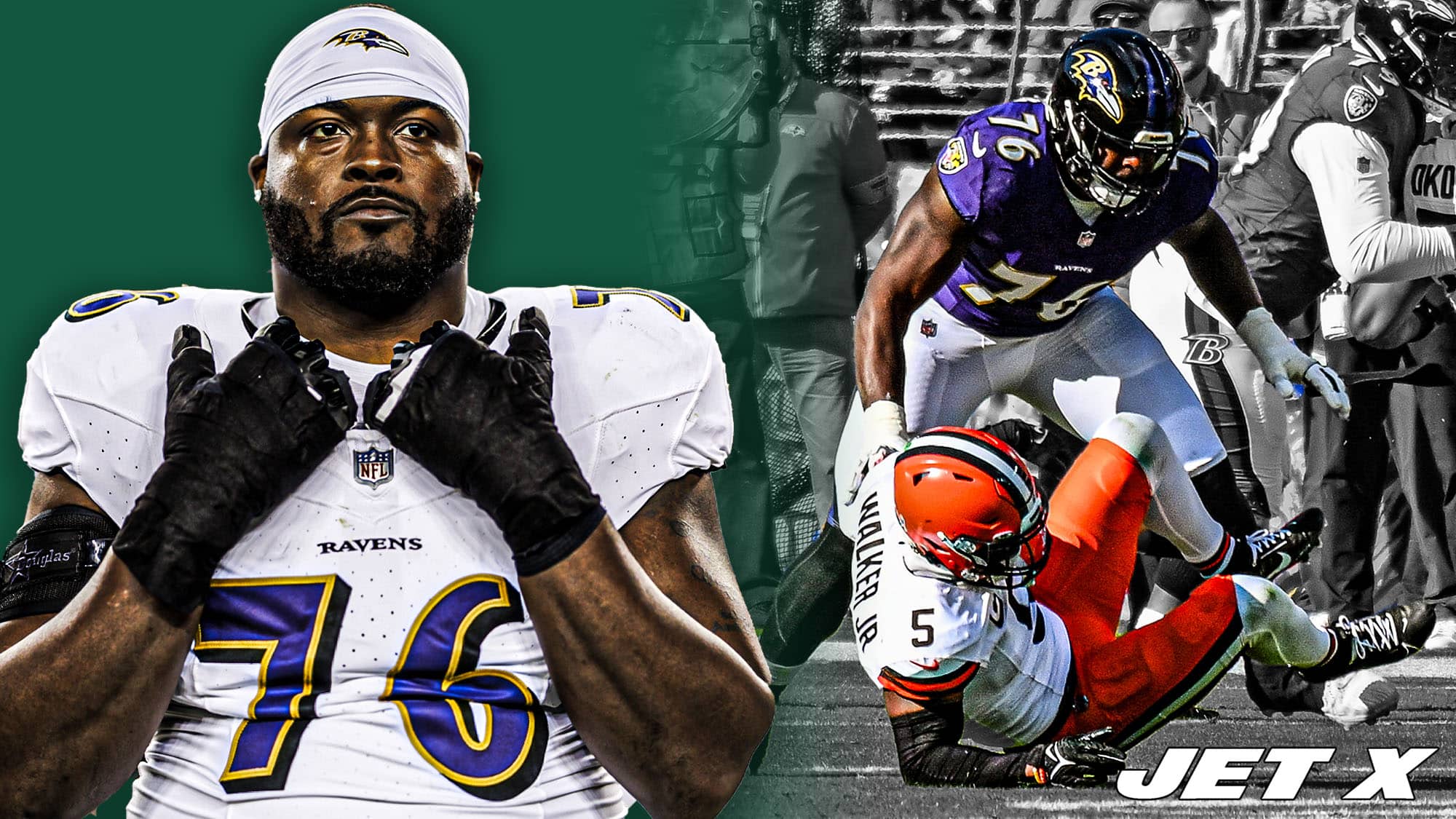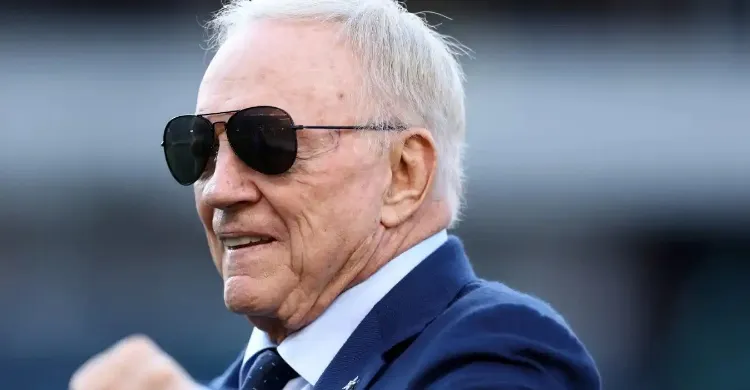Don’t overlook John Simpson when discussing the New York Jets’ offensive line

Everyone’s talking about Olu Fashanu, Tyron Smith, and even Morgan Moses. And for good reason! All three players are major additions to a New York Jets offensive line that desperately needed an infusion of talent. Considering this trio includes a first-round pick and two well-known veterans, it makes sense they are attracting most of the attention.
We can’t leave out John Simpson, though. The 26-year-old left guard is flying under the radar in discussions about the Jets’ O-line overhaul.
And it’s understandably so. At a contract of two years and $12 million with just $6 million guaranteed, he’s viewed as a replacement-level stopgap. Expectations for him are modest.
Despite his contract and lack of fanfare, I can’t help but be excited about this dude. Whenever I watch him on film, I consistently come away feeling like he’s far better than what he’s billed as. Call me crazy, but I feel like the Jets could be getting a top-15 starting left guard in Simpson.
What does Simpson bring to the table?
Simpson is a fascinating player to evaluate, as there are a ton of mixed signals regarding the caliber of player he truly is.
His run-blocking resume is a perfect example. Based on the evidence at hand, it’s tough to definitively state where he ranks in this phase. Statistically, it’s not a pretty picture, as he posted subpar rankings in both Pro Football Focus’s run-blocking grade (56.9, ranked 49th out of 79 qualifiers) and ESPN’s run-block win rate (66.3%, 67th) in 2023. On the contrary, he has a public reputation as a mauling run-blocker. He is more well-known for his work on the ground than in pass protection.
It’s hard to tell what type of impact Simpson will make in the run game. But what I can say with relative certainty is that he will be a very solid pass protector for the Jets. The evidence is everywhere.
Simpson’s 2023 pass-blocking ratings were unanimously excellent. Among 79 qualified guards, Simpson ranked 21st in PFF’s pressure rate (4.19%), 21st in NFL Next Gen Stats’ pressure rate (6.53%), and 24th in ESPN’s pass-block win rate (92.5%). His consistency across all three metrics is extremely notable since there tends to be high variance across offensive line metrics (something we just broke down regarding Alijah Vera-Tucker). Since every metric agrees that Simpson was a top-25 pass-blocker among 79 qualified guards, it’s unlikely the numbers are lying to us.
Adding to Simpson’s appeal as a pass-blocker is his ability to hold up for long periods of time. In Baltimore, Simpson had to protect Lamar Jackson, who holds the football longer than most quarterbacks in the league. This makes the offensive linemen’s jobs more difficult. Yet, Simpson still earned strong pass-blocking ratings across the board.
One metric reflects Simpson’s ability to protect on long-developing plays. According to NFL Next Gen Stats, Simpson averaged 3.32 seconds from snap to pressure, ranking ninth-best among guards and fifth-best among left guards. This means that, even when Simpson did get beat, it usually took a relatively long time, so the pressures he allowed were far less costly than those of the average guard.
It’s puzzling to me that Simpson was valued at just $6M guaranteed on the free agent market when he was coming off such an impressive year in the passing game. Even with his question marks in the run game, teams should have jumped all over the opportunity to add a 26-year-old starting guard with excellent pass-blocking production.
Simpson’s low market value relative to his pass-blocking metrics raises the question of whether those metrics are legitimate. However, as we mentioned earlier, the fact that every metric paints the same picture is a sign they are not lying to us. So, what could have caused teams to devalue him?
Perhaps the league wrote off Simpson’s pass-blocking numbers as a product of Baltimore’s well-oiled offensive machine. The Ravens have been cycling linemen in and out of their lineup for many years with few issues, consistently making most players look good in their system. They haven’t ranked lower than 14th in PFF’s team pass-blocking grade since 2012. It’s a well-coached and well-run organization that excels at developing talent, especially in the trenches. So, this is conceivably a justifiable reason for teams to be skeptical of buying into Simpson’s production.
Countering that argument is Simpson’s film. In my view, Simpson’s film backs up his success as a pass blocker, proving his numbers are legitimate and that he is not a scheme product.
No game shows it better than his masterclass against the 49ers’ elite defensive line in Week 16. Spending much of the game matched up with two-time Pro Bowl defensive tackle Javon Hargrave, Simpson allowed just one pressure on 44 pass-blocking snaps, per PFF, playing a key role in the Ravens’ road blowout win.
Here are some plays against San Francisco that solidify Simpson’s standing as a solid pass-blocker.
John Simpson film vs. 49ers
Simpson lines up at left guard and wears No. 76.
Going one-on-one against future Jets DT Javon Kinlaw, Simpson devours the bull rush attempt and anchors down with plenty of space between himself and Lamar Jackson. Simpson then begins to push back on Kinlaw, continuing to drive his legs until he pummels Kinlaw into the turf. In fairness to Kinlaw, he only fell because he stepped on No. 64’s foot, but nonetheless, this is a dominant rep by Simpson in a one-on-one situation where the QB holds the ball for a long time.
Going up against two-time Pro Bowl DT Javon Hargrave, Simpson takes an aggressive set, quickly engaging Hargrave out of his stance. Matching Hargrave’s aggressiveness, Simpson is able to get his hands into Hargrave’s body and stave off the bull rush attempt, keeping him far away from the QB.
In another one-on-one against Hargrave, Simpson holds up on an island for over four seconds before Hargrave finally gets loose. Simpson comes off the ball aggressively with a “hug” technique – a wide punch intended to grab the defender’s shoulder pads. However, this move concedes Simpson’s chest, which allows Hargrave to get into him on the bull rush and drive him back a couple of steps at the start of the rep. Despite the early advantage for Hargrave, Simpson recovers in a hurry. He quickly gets his feet under him and reworks his hands into Hargrave’s chest. With his feet anchored and his hands inside, Simpson seizes control and starts driving Hargrave outside.
It’s a tremendous rep against a star pass rusher, helping to create a gigantic pocket for Jackson. Simpson consistently shows the ability to absorb bull rushes, a testament to his lower-body strength.
Hargrave gives one step downhill before throwing the crossover on Simpson, trying to draw him inside so Fred Warner has space to go outside on the stunt. Simpson not only stays with Hargrave on the move, but he still recognizes the stunt and handles his responsibilities. Simpson mirrors Hargrave to the inside, effectively passes him off to the center, and then gets back outside to pick up Warner.
Left without an assignment, Simpson does a good job of finding work and making himself useful. Simpson sees the DT crossing his face and rushing toward the middle, so he leaves him for the center and starts turning his head outside. In the meantime, though, Simpson leaves his inside hand extended to feel if he’s needed inside (in case the DT enters that gap). Feeling no threat from the DT, Simpson confirms he can go outside to help on the edge. The LT is losing on the bull rush and appears on the verge of being walked back into the QB, but Simpson arrives to stymie the rush before it can affect the pocket. Simpson pushes the rusher upfield, opening up an enormous scrambling lane for Jackson.
Another clean stunt pickup against a Hargrave crossover. Simpson catches Hargrave’s chest with his right hand to halt his momentum and then uses both hands to shove him inside toward the help. In the process, he uses the momentum to propel himself off Hargrave and push back outside to pick up the looper.
Kinlaw tries to hit Simpson with an outside swim move after jabbing inside, but he telegraphs it from a mile away, and Simpson easily shuts it down by hitting his exposed chest with a two-hand punch while he’s in the midst of bringing his arm over. Kinlaw’s first step is overly exaggerated and relatively slow, tipping off the outside swim to Simpson. If you watch it frame by frame, you can see that Simpson is already gearing up to punch Kinlaw just fractions of a second after the snap – long before Kinlaw even starts bringing his arm over. Good film study likely also contributed to Simpson anticipating this move so easily.
Don’t forget to mention John Simpson in your discussions about the Jets’ revamped offensive line. While his modest contract and lack of fanfare suggest that fans should expect him to be a mediocre stopgap starter, the metrics and film suggest otherwise. I’m not saying we should start taking measurements for his Canton bust, but I feel comfortable predicting that Simpson will be a top 10-15 left guard this year. I love his game and I think Jets fans will feel the same once they see him on the field.
Subscribe to become a Jet X Member to unlock every piece of Jets X-Factor content (film breakdowns, analytics, Sabo with the Jets, etc.), get audio versions of each article, receive the ability to comment within our community, and experience an ad-free platform experience.



